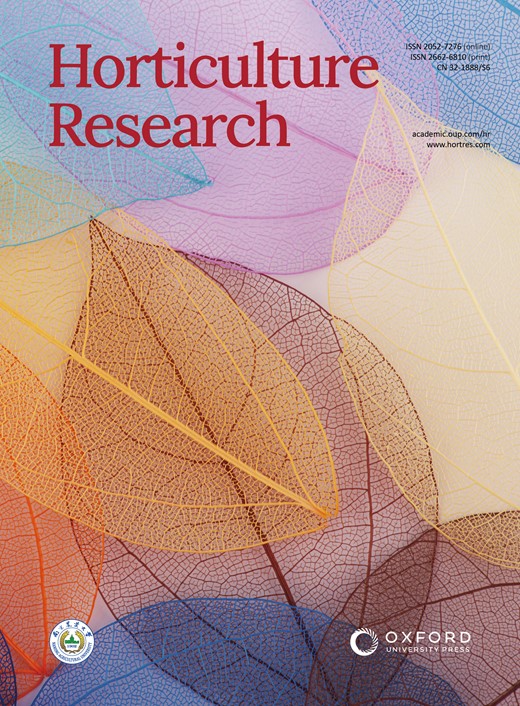综合连锁定位、GWAS和RNA-Seq分析揭示了菊花F1种间后代耐旱性的遗传结构和候选基因
IF 8.5
1区 农林科学
Q1 Agricultural and Biological Sciences
引用次数: 0
摘要
干旱胁迫是严重影响植物生产的主要环境制约因素。然而,在菊花物种中,遗传基础主要被误解。本研究旨在通过连锁定位、全基因组关联研究(GWAS)和RNA-seq分析等方法,研究菊花(Chrysanthemum dichrum)和南京菊(Chrysanthemum nankingense)亲本F1代的耐旱性遗传变异,并鉴定候选基因。结果表明,所研究性状对干旱胁迫的响应存在广泛差异,互交间耐旱性遗传差异显著。这证实了杂交方向对抗旱表型的影响。采用测序基因分型(GBS)方法,绘制了一个高分辨率遗传图谱,包含6677个非冗余bin标记,跨越9个连锁群(LGs),全长1859.31 cM,平均标记密度为0.28 cM。包括复合区间作图(ICIM)检测到89个显著数量性状位点(qtl), GWAS在Single_Env算法中鉴定出1360个显著数量性状核苷酸(QTNs),在Multi_Env算法中鉴定出394个显著数量性状核苷酸(QTNs)和114个定量上位相互作用(QEIs),以及6对与耐旱性相关的上位位点(QEs)。除了加性效应外,我们还观察到显著的显性和上位性效应,这解释了为什么抗旱性在正交中表现出负杂种优势。整合QTL定位和GWAS发现了38个共定位位点,包含10个已知基因和15个新的候选基因,其中8个通过RNA-seq和qRT-PCR分析验证。此外,我们在候选基因Cn1062070中鉴定出具有更高耐旱性的精英单倍型。研究结果有助于阐明菊花品种的耐旱遗传结构,为培育耐旱品种提供宝贵的遗传资源。本文章由计算机程序翻译,如有差异,请以英文原文为准。
Integrative linkage mapping, GWAS, and RNA-Seq analysis unravel the genetic architecture and candidate genes for drought tolerance in Chrysanthemum interspecific F1 progeny
Drought stress is a major environmental constraint that severely impacts plant production. However, the genetic basis is primarily misunderstood in chrysanthemum species. The objectives of this study are to examine the genetic variation of drought tolerance in reciprocal F1 progenies of Chrysanthemum dichrum (drought-tolerant) and Chrysanthemum nankingense (drought-sensitive) and identify candidate genes by integrating linkage mapping, genome-wide association study (GWAS), and RNA-seq analysis. The results revealed extensive variation for the investigated traits in response to drought stress and notable genetic divergence in drought tolerance between the reciprocal crosses. This confirms that the hybridization direction influenced drought tolerance phenotypes. A high-resolution genetic map containing 6,677 non-redundant bin markers spanning 1859.31 cM across nine linkage groups (LGs), achieving an average marker density of 0.28 cM, was developed with a genotyping-by-sequencing (GBS) approach. The inclusive composite interval mapping (ICIM) detected 89 significant quantitative trait loci (QTLs), and GWAS identified 1,360 significant quantitative trait nucleotides (QTNs) in Single_Env, 394 QTNs, and 114 quantitative epistatic interactions (QEIs) in the Multi_Env algorithm, as well as six pairs of epistatic loci (QEs) related to drought tolerance. Besides the additive effects, we observed considerable adverse dominant and epistatic effects for the significant loci, explaining why drought tolerance exhibits negative heterosis in reciprocal crosses. The integration of QTL mapping and GWAS revealed 38 co-localized loci harboring ten known and 15 novel candidate genes, eight validated through RNA-seq and qRT-PCR analyses. Moreover, we identified elite haplotypes yielding higher drought tolerance within the candidate gene Cn1062070. The findings help elucidate the genetic architecture of drought tolerance in chrysanthemum species and provide valuable genetic resources for the development of drought-tolerant cultivars.
求助全文
通过发布文献求助,成功后即可免费获取论文全文。
去求助
来源期刊

Horticulture Research
Biochemistry, Genetics and Molecular Biology-Biochemistry
CiteScore
11.20
自引率
6.90%
发文量
367
审稿时长
20 weeks
期刊介绍:
Horticulture Research, an open access journal affiliated with Nanjing Agricultural University, has achieved the prestigious ranking of number one in the Horticulture category of the Journal Citation Reports ™ from Clarivate, 2022. As a leading publication in the field, the journal is dedicated to disseminating original research articles, comprehensive reviews, insightful perspectives, thought-provoking comments, and valuable correspondence articles and letters to the editor. Its scope encompasses all vital aspects of horticultural plants and disciplines, such as biotechnology, breeding, cellular and molecular biology, evolution, genetics, inter-species interactions, physiology, and the origination and domestication of crops.
 求助内容:
求助内容: 应助结果提醒方式:
应助结果提醒方式:


